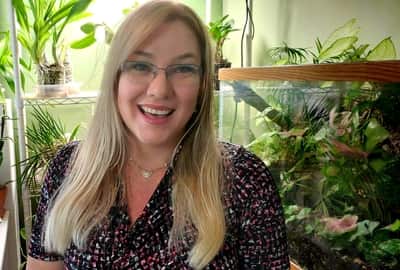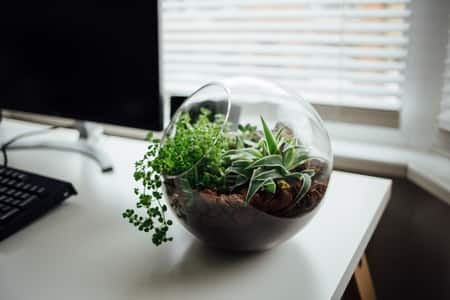Most orchid terrariums don’t survive after a few months after mounting because they become saturated with stagnant and impure water, causing bacteria proliferation. The substrate becomes putrid, with no exit for the condensation, except to fall on the already supersaturated substrate. The result is a horrifying smell and dead orchids.
Even if you water and mist in the correct doses, excess humidity inside the terrarium happens for two reasons: tainted water remains in constant contact with the substrate, and the substrate is too compacted for decent airflow. A false bottom is a perfect solution to fixing both those problems, making your orchid terrarium thrive from the bottom up.
False Bottoms on Terrariums
The following video is how I set up the false bottom in my orchid terrarium. Since it will have filler plants, I used normal potting soil, but if you are using only orchids, you can change the mix.
https://www.youtube.com/embed/TOC5tNk0bQM
Why Does the Water in a Terrarium “Go Bad”?
First, let’s understand exactly what is happening to the terrarium in terms of water droplets.
When you mist your terrarium, be it closed or open, the water droplets will stay in the air for the first two hours. With gravity, they fall onto the leaves and potting soil used as a substrate layer.
Note: In this article, I’m mainly referring to orchid terrariums that use orchid bark, charcoal, sphagnum moss, peat moss, and perlite as a substrate layer. If you aren’t growing orchids in your terrariums but other plants, your soil must be different. In most cases, this effect will be more severe and extreme, since normal soil compacts quicker than orchid bark. So, the same applications for the false bottom are valid.
Without a false bottom, the water droplets precipitate onto the substrate layer, penetrate the potting mix, and stay there indefinitely. Sitting water… The world’s major health issues derive from sitting water: dengue, malaria, cholera, hepatitis, and many others.

Stagnant water is the perfect environment for bacteria.
If you have an open terrarium, the water will eventually evaporate, leaving the substrate.
This only happens if the substrate isn’t compacted down by the water.
If your level of the substrate has become so thick and dense that air has a hard time circulating through it, the water will not evaporate before it’s time to mist again, making the problem even worse.
If your terrarium is closed, the evaporation process will still occur, but at a slower rate. Yet, the water droplets condensate and precipitate again onto the soil—back to ground zero.
Water weighs down on the soil over time, even if it’s a harder and denser material, such as charcoal. This potting mix layer of a substrate will become compacted with continual misting, preventing proper airflow and circulation that are necessary for orchid growth.
The same reasoning applies to the pots and is why you need to repot every two years (give or take). In a terrarium, our goal is quite a bit longer—much longer.
Water gets trapped in between the glass and the soil, creating an anaerobic environment. There is less gas exchange beneath the soil, and bacteria crank up the music for an in-house party. Not only root-rot and bacteria build-up will occur, but also bacterial brown spot, fungus or mildew related problems.
At first, bacteria will consume only the oxygen but when they become overwhelming inside the substrate, they also consume methane and sulfides, which are important for plant growth. Some bacteria release these elements, but for the majority, they consume more than they release, causing a deficit in the potting medium. Without these two elements, orchid roots become increasingly susceptible to disease and die off.
This article written by Dr. Susanne Benner, at Max Planck Society and published on Phys Orb explains the chemistry behind that process. This other article
written by Dr. Susanne Benner, at Max Planck Society and published on Phys Orb explains the chemistry behind that process. This other article by ProMix explains why sulfur is important to plant growth.
by ProMix explains why sulfur is important to plant growth.
The Purpose of the False Bottom in Orchid Terrariums
The purpose of the false bottoms in terrariums is to hold the excess water, keep water away from the roots (creating a drainage level), and yet still keep the terrarium humid.
Let’s look at those one by one.
Building a terrarium false bottom is a guaranteed way to separate the water from the substrate layer, adding extra airflow around the roots. In essence, you are creating a drainage layer that is entirely separate from the substrate.
No more soggy roots.
The false bottom will still keep the roots humid allowing water to penetrate the substrate.
This clean water trickles into a separate container—a reservoir—underneath the substrate. Without the water directly touching the roots or the substrate, the potting medium will not break down as fast, keeping airflow to the adequate level for healthy orchids. (By the way, to know if your orchid is healthy or not, in this article I specified 13 signs of a healthy orchid).
Compacted substrate will decay slower—much slower. The accumulated water in the bottom layer (that imitates a reservoir) will evaporate easier with a false bottom in place. This maximizes the efficiency of the evaporation cycle, leaving the roots moist but not soggy.
How to Build the False Bottom Layer in an Orchid Terrarium
There are several different ways to go about building a false bottom in a terrarium. In all of them, your aim is to build a hidden well under the substrate that won’t let the potting medium through, only water. For this, you’ll need to use materials that doesn’t degrade. Here are my suggestions:
Part 1: Choosing Your False Bottom Material
Gravel
River Rocks
Pebbles
Aquarium Rocks
Leca Pebbles
Lava Rocks
Marbles
Egg Crate
Decorative Garden Rocks

Get creative and use your imagination. This is the fun part of orchid care, besides watching the orchid bloom, of course. Whatever material you use, it has to be the less porous possible. This layer is from where the water will accumulate and eventually evaporate.
Needless to say, not all water will evaporate, leaving a constant thin layer of water at all times.
If your material is porous or water-absorbent, in time, your reservoir will become bacteria-infested.
I’ve read of people using sand for this bottom layer, but I’ve never done it. In my opinion, it wouldn’t allow for airflow, so that is why I’ve never tried it. If you’ve used sand, please comment below and tell me how that worked for you.
Part 2: Separating the Reservoir from the Substrate
The second part is to separate this reservoir with a material that will not allow the substrate to fall through. Window screen or mesh is perfect for this. You can also look for geotextile fabric.
The holes are wide enough for the water to fall freely yet small enough for the substrate to stand on top of it. Whatever you use, make sure it’s not biodegradable. You don’t want this layer to decompose.
Cut the measurements wider and longer than the glass you have, so it will curl upward at the edges. This holds the substrate layer in a lot better, gripping it like a glove. You don’t want the substrate on top of this layer to penetrate the false bottom, which would put the entire process at a loss.
Part 3: Adding Your Substrate to the False Bottom Orchid Terrarium
Before you sprinkle the substrate on top of the separating mesh, add activated carbon or charcoal. This extra step purifies the water that has seeped through the substrate before it reaches the reservoir.
I won’t explain all the benefits of charcoal here because I wrote an article about why I add charcoal to all my terrariums (and pots too for that matter) and why charcoal is beneficial. You can read that here.
The charcoal layer doesn’t have to be thick, just as long as is covers the bottom.
Now you can add your substrate layer.
To those NOT building orchid terrariums, go with a potting soil of your preference. To the orchid growers, stick with orchid bark, sphagnum, and perlite. You can add sand to this layer if you’d like.
If you’re going with terrestrial plants, like Paphiopedilums of Phragmipediums, then peat moss is a good addition, too. Leaf litter is also a wise decision not only for looks but also for additional nutrients for the terrestrial orchids.
Part 4: Adding the Clean-Up Crew to the False Bottom
The last part of the false bottom creation is the addition of isopods or springtails. Bugs? Yes, throw those little dudes inside your setup, even if you have to close your eyes to do it. They are the clean-up crew. They are hardly noticeable and will feed on the bacteria before it has time to proliferate into numbers that are damaging.
Not all little creatures are terrible for your orchids. Despite the fact that I write numerous articles on bugs that infest sphagnum moss, and bugs that infest orchid bark, and several other articles of that nature, there are beneficial bacteria and beneficial insects, bugs, and critters that aid your orchid. So, let’s give them due credit and a happy home.
Springtails will eat the green mold and algae off the sides of the terrarium. If you’re having problems with green algae in your orchid pots and terrariums, this article I wrote talks about how harmful green algae is (or isn’t) inside your orchid pot.
While you’re at it, add a few ladybugs, too… Ladybugs can’t hurt and they eat some of the pests, like spider mites and mealy bugs, that are hard to get rid of.
Don’t Stop Learning!
If you want to be included in more information and get a 14-page fertilization guide, please sign up for my newsletter. I don’t spam, but send emails out bi-monthly with some curious topics of interest. If you want more information, click here to go to a specific page on this website where I explain it more in detail.

Also, if you are looking for an orchid journal to keep your notes specifically about orchid care, check out my 2 solutions for that on this page. If note-keeping isn’t your thing, then there is a free excel spreadsheet that you can download. Click here for more information on how to do that.
If you subscribe to my newsletter, I will send you a 14-page guide on the main tips of orchid fertilizer. It is downloadable and you can print it out on your computer. I designed the guide to double up as a coloring book, just to make it fun.
In all, a false bottom in an orchid terrarium is the best way to filter the water and maintain it separated from the substrate. You can add a step further by adding a drainage siphon or a water valve so you can eventually drain the excess water. (That’s a whole different tutorial.)
If you have a high-humidity, closed terrarium, that gets misted every day, this might be a necessity in the long run. For most terrariums that are open, just the false bottom is enough to guarantee that fresh, moist but not soggy substrate.
Happy cultivating!

